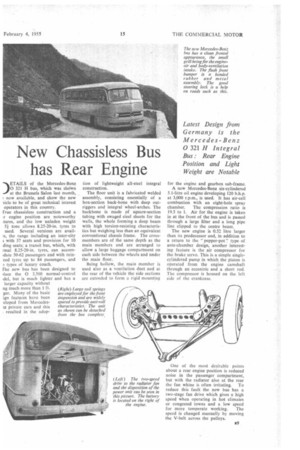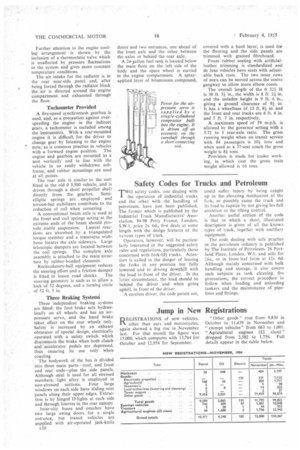New Chassisless Bus has Rear Engine
Page 55

Page 56

If you've noticed an error in this article please click here to report it so we can fix it.
Latest Design from Germany is the Mercedes-Benz 0 321 H Integral Bus : Rear Engine Position and Light Weight are Notable )ETA1LS of the Mercedes-Benz 0 321 H bus, which was shdwn at the Brussels Salon last month, _ : now available, and show the new Ude to be of great technical interest operators in this country.
[rue chassisless construction and a Lr engine position are noteworthy tures, and the low unladen weight 5i tons allows 8.25-20-in. tyres to used. Several versions are availle, the range including an inter-city r with 37 seats and provision for 10 ding seats; a transit bus, which, with rmal 8.25-20-in. tyres, can accomdate 50-62 passengers and with reinced tyres up to 84 passengers, and ) types of luxury coach.
[he new bus has been designed to lace the 0 3,500 normal-control 'del, but is much lighter and has a larger capacity without ng much more than 1 ft.
ger. Many of the basic ign features have been eloped from Mercedes lz private cars and this resulted in the adop tion of lightweight all-steel integral construction.
The floor unit is a fabricated welded assembly, consisting essentially of a box-section back-bone with deep outriggers and integral wheel-arches. The backbone is made of square-section tubing with swaged steel sheets for the walls, the whole forming a deep beam with high torsion-resisting characteristics but weighing less than an equivalent conventional chassis frame. The crossmembers are of the same depth as the main members and are arranged to allow a large baggage compartment on each side between the wheels and under the main floor.
Being hollow, the main member is used also as a ventilation duct and at the rear of the vehicle the side sections are extended to form a rigid mounting for the engine and gearbox sub-frame, A new Mercedes-Benz six-cylindered 5.1-litre oil engine developing 120 b.h.p. at 3,000 r.p.m., is used. It has air-cell combustion with an eight-hole spray chamber. The compression ratio is 19.5 to 1. Air for the engine is taken in at the front of the bus and is passed through a large filter and a long pipe line clipped to the centre beam.
The new engine is 0.52 litre larger than its predecessor and, in addition to a return to the "pepper-pot 7 type of ante-chamber design, another interesting feature is the air compressor for the brake servo. This is a simple singlecylindered pump in which the piston is operated from the engine camshaft through an eccentric and a short rod. The compressor is housed on the left side of the crankcase.
One of the most desirable points about a rear engine position is reduced noise in the passenger compartment, but with the radiator also at the rear
the fan whine is often irritating. To reduce this fault the new bus has a Iwo-stage fan drive which gives a high speed when operating in hot climates or congested towns and a low speed for more temperate working. The speed is changed manually by moving the V-belt across the pulleys. Further attention to the engine cooling arrangement is shown by the inclusion of a thermostatic valve which is unaffected by pressure fluctuations in the system and gives more constant temperature conditions.
The air intake for the radiator is in the rear near-side panel and, after being forced through the radiator block the air is directed around the engine compartment and exhausted through the floor.
Tachometer Provided A five-speed synchromesh gearbox is used, and, as a precaution against overspeeding the engine in the indirect gears, a tachometer is included among the instruments. With a rear-mounted engine it is difficult for the driver to change gear by listening to the engine note, as is common practice in vehicles with a forward engine position. The engine and gearbox. arc mounted as a unit vertically and in line with the vehicle in an easily withdrawn subframe, and rubber mountings are used at all points.
The rear axle is similar to the unit fitted in the old 0 3,500 vehicle, and is driven through a short propeller shaft directly from the gearbox. Semielliptic springs arc employed and torsion-bar stabilizers contribute to the reduction of roll when cornering.
A conventional beam axle is used at the front and coil springs acting at the extreme ends of the beam should provide stable suspension. Lateral reactions are absorbed by a triangulated torque member and a transverse wishbone locates the axle sideways. Large telescopic dampers are located between the coil springs. The complete axle assembly is attached to the main structure by rubber-bonded elements.
Recirculatory-ball equipment reduces the steering effort and a friction damper is fitted to lessen road shocks. The steering geometry is such as to allow a lock of 52 degrees, and a turning circle of 52 ft. 5 in.
Three Braking System4
Three independent braking systems are fitted: the foot brake acts hydraulically on all wheels and has an airpressure servo, and the hand brake takes effect on the rear wheels only. Safety is increased by an exhaust obturator of special design, electrically operated with a safety switch which disconnects the brake when both clutch and accelerator pedals are depressed, thus ensuring its use only when coasting.
The bodywork of the bus is divided into three main parts—roof, and front and rear ends—plus the side panels. Although steel is used for all stressed members, light alloy is employed in non-stressed sections. Four large windows on each side have sliding vent panels along their upper edges. Extraction is by hinged D-lights at each side and through louvres in the rear canopy.
Inter-city buses and coaches have two large swing doors for a single entrance, but transit vehicles are supplied with air-operated jack-knife doors and two entrances, one ahead of the front axle and the other between the axles or behind the rear axle.
A 24-gallon fuel tank is located below the main floor on the left side of the body and the spare wheel is carried in the engine compartment. A sprayapplied layer of bituminous compound,
covered with a hard layer, is used for the flooring and the side panels are trimmed with grained fibreboard.
Foam rubber seating with artificialleather trimming is standardized and de luxe vehicles have seats with adjustable back rests. The two inner rows of seats can be moved across the centre gangway to allow more elbow room.
The overall length of the 0 321 14 is 30 ft. 31 in., the width is 8 ft. 21 in. and the unladen height is 9 ft. 6 in., giving a ground clearance of 91 in. It has a wheelbase af 13 ft. 81 in. and the front and rear tracks are 6 ft. 4 in. and 5 ft. 7 in. respectively.
A maximum speed of 59 m.p.h. is allowed by the governor setting with a 5.72 to 1 rear-axle ratio. The gross running weight when on transit service with 84 passengers is 101 tons and when used as a 37-seat coach the gross weight is 81 tons.
Provision is made for trailer working, in which case the gross train weight allowed is 16 tons_




















































































































